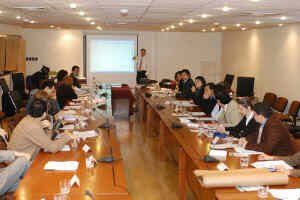Public Participation Guide: Introduction to Public Participation
What is public participation?

The section of this guide titled Selecting the Right Level of Public Participation discusses the different forms that public participation might take depending on the potential for public influence on a decision. These forms include:
- informing the public by providing information to help them understand the issues, options, and solutions
- consulting with the public to obtain their feedback on alternatives or decisions
- involving the public to ensure their concerns are considered throughout the decision process, particularly in the development of decision criteria and options
- collaborating with the public to develop decision criteria and alternatives and identify the preferred solution
- empowering the public by placing final decision-making authority in their hands.
Depending of the form of participation sought, public participation makes use of a variety of tools and techniques to inform the public, generate public input, and, in some cases, build consensus and reach agreement.
What are the benefits of public participation?
- Sponsor agencies will make better and more easily implementable decisions that reflect public interests and values and are better understood by the public.
- Communities develop long-term capacity to solve and manage challenging social issues, often overcoming longstanding differences and misunderstandings.
Learn more: Benefits of Public Participation
How does public participation result in better decisions?
Public participation contributes to better decisions because decision-makers have more complete information – in the form of additional facts, values, and perspectives obtained through public input – to bring to bear on the decision process. They can then incorporate the best information and expertise of all stakeholders. Decisions are more implementable and sustainable because the decision considers the needs and interests of all stakeholders including vulnerable/marginalized populations, and stakeholders better understand and are more invested in the outcomes.
As a result, decisions that are informed by public participation processes are seen as more legitimate and are less subject to challenge. Decision-makers who fully understand stakeholder interests also become better communicators, able to explain decisions and decision rationale in terms stakeholders understand and in ways that relate to stakeholders’ values and concerns.
How does public participation develop community capacity?
Another major result of sustained stakeholder participation in decisions and their implementation is the development of capacity for managing difficult social problems. This capacity includes improved relationships and trust between decision-makers and the public, and among different stakeholders themselves. Also, when done well, public participation helps to teach stakeholders meaningful and collaborative ways to approach each other, manage difficult decisions, and resolve disputes. Stakeholders learn to appreciate each others’ positions by first learning about each others’ values and interests.
Once stakeholders are invited into the decision process, it becomes more difficult for them to merely stand to the side and say “no.” As participants in good decision-making processes, all stakeholders must understand all sides of an issue, weigh the pros and cons, and make more thoughtful decisions. Stakeholders and communities do not generally achieve this on their own. Sponsoring agencies must recognize their responsibility to help communities build their capacity for collaborative problem solving.
This community model facilitates collaboration to address environmental and/or public health issues in distressed communities.
Think About Community Capacity Building as Part of Public Participation
- Modeling the behaviors that you want to see exhibited throughout the process
- Developing and sharing with the public guidance documents that promote the core values of public participation and delineate best practices
- Providing training to community leaders and stakeholder representatives in foundational public participation and communication skills
- Giving special consideration and attention to vulnerable populations and marginalized communities.
- Identifying facilitative leaders within sponsor agencies to mentor community groups/leaders by partnering with them during the planning and implementation of public participation processes. Inviting the public to participate in planning the process can create a sense of ownership among the public
- Hiring professional third-party facilitators to provide instruction at the project outset to sponsor agency staff and external stakeholders on participatory behaviors and techniques
- Where appropriate, using deliberative forums that encourage more active forms of participation instead of selecting forums that are viewed by sponsor agencies as being more “safe” because they control participation
- Providing technical assistance to the public or community groups to help them understand technical information relevant to the decision.
What are the necessary conditions for successful public participation?

- Clear purpose and goals – a well-defined purpose for the public’s role in the project that is real, practical, and shared among stakeholders. Sponsoring agencies must determine the appropriate level or degree of public participation for the decision at hand and set the public’s expectations accordingly. No one benefits when agencies promise more in the way of public participation than they are willing to commit to and deliver. In fact, making promises that cannot be kept will undermine public confidence in the public participation process
- Clear structure and process – well-defined rules about how public participation will be conducted and how the decision will be made
- Actual opportunity for influence – the real opportunity for public input to be considered in making the decision
- Commitment to the process – managers and staff alike must be committed to the full range of activities required to make public participation work and be willing to obtain and consider public input in making the decision
- Inclusive and effective representation – reaching out to representatives of the full range of relevant stakeholder interests regardless of race, color, national origin, sexual orientation or income.
What are some additional considerations for successful public participation?
- Sufficient resources to conduct the process – provide the funding and staff to support all aspects of the process, including a situation assessment, outreach activities, and obtaining and incorporating public input, with resources dedicated to involving vulnerable populations and overburdened parts of the community
- Participative capacity among staff and participants – conduct training in communication, outreach, and collaborative problem solving skills
- A climate of integrity – trust and credibility of government are essential for public participation. Public participation will not flourish where government agencies or decision makers are corrupt or disingenuous about considering public input
- A belief in the value of public input – the knowledge that public input will result in better decision-making and that public participation results in better governance
- Capacity to engage - ensuring that agencies know how to design and implement public participation processes, and that agencies and the public alike have the knowledge and communication skills to participate effectively in the process
- Complete transparency – the timely sharing of easily understandable and accessible information to educate the public about the issues and options.
Although the conditions and responsibilities for public participation are significant, you should not feel daunted. Rather, public participation should be viewed as an opportunity to make a powerful decision – one that resolves issues to the broadest possible satisfaction and benefit of interested parties. When done well, the time and effort invested in public participation pay dividends by resulting in a more broadly acceptable, implementable, and sustainable decision.
